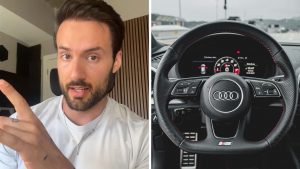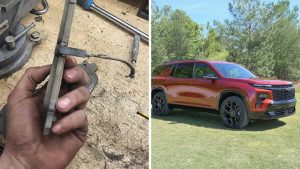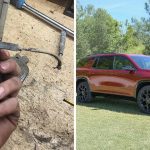Safety
Old VW Golf Meets Modern Crash Test: Proof of How Far Car Safety Has Come
Had there been people inside the Golf Mk2, they would’ve had little chance of surviving.
Enthusiasts and journalists often complain about car bloat. Today’s vehicles are noticeably bigger and heavier than those from a few decades ago, with much of that added bulk dictated by safety regulations. Still, you’re far more likely to survive a head-on collision in a modern car than in an equivalent model built 20-30 years ago. This new crash test of an old Volkswagen serves as a stark reminder of how much car safety has advanced.
Dekra, an independent car safety organization founded in Berlin in 1925, put a second-generation Golf through the rigor of a modern crash test. The goal was to showcase how far safety has come by comparing the 1989 hatchback with its present-day successor, an eighth-gen example built in 2024. For this unusual test, the German testing, inspection, and certification body managed to secure a 36-year-old car in excellent technical condition.
At its crash test center in Neumünster, Dekra launched the Golf II into a barrier at about 40 mph (60 km/h), simulating the frontal crash test procedure used by Euro NCAP until 2020. The barrier was equipped with a deformation element to mimic the energy absorption of an opposing vehicle. Under these conditions, the test reproduced a head-on collision between two identical cars traveling at 31-34 mph (50-55 km/h).
As if the scary aftermath images weren’t convincing enough, a Dekra expert summed up the results grimly: “In the Golf II, occupants would have had little chance of surviving this head-on collision due to the collapse of the passenger compartment, the deep penetration of vehicle components into the passenger compartment, the deceleration and the impact on the steering wheel.”
The outcome was very different for the Golf VIII tested under the exact same conditions. Had it been occupied, passengers likely would have walked away with only minor injuries: “The entire passenger compartment remained completely intact, and the occupants were very well protected by the front and side airbags in combination with the seat belts, belt tensioners, and belt force limiters.”
Dekra didn’t stop at crashing a 1989 Golf in the name of safety. Braking tests revealed the eighth-gen car needed about 30 percent less distance to come to a full stop. Cornering stability was also examined in a maneuver test, with the modern VW safely completing it at 47 mph (75 km/h) compared to just 40 mph (65 km/h) for its predecessor.
The differences extended to visibility as well. The new car’s standard LED headlights proved to be “in a completely different league” than the halogen bulbs of its ancestor. At the rear, LED taillights improved visibility for following drivers, enhanced further by the third brake light absent on the 1989 model. It’s worth mentioning that the extra brake light wasn’t mandated in Europe until the late 1990s, though some cars had adopted it sooner.
While the simplicity of an old car certainly has its charm, there’s no denying that a Golf II looks more like a death trap compared to its modern counterpart.
See Other Crash Tests:
News
‘It’s Kinda Giving Walmart Carts’: Woman Starts Driving Her Honda. Then She Realizes Her Rear Tire Isn’t Turning
“God forbid a tire gets tired.”
It takes a few seconds to notice it, but once you do, you can’t look away: as a Honda creeps across an icy road, one of the rear wheels stays perfectly still, locked in place while the rest of the car moves.
A viral TikTok with more than 11 million views erupted with jokes, theories, and actual mechanical diagnoses, all trying to explain how a wheel can just…decide not to participate.
“I’m no mechanic, but I don’t think a car is supposed to do that,” frustrated motorist @youloveeash wrote in the caption, and you can sense the bewildered sarcasm that she’s trying to convey to her viewers.
Once the clip circulated beyond the creator’s corner of TikTok, the comments section became a case study in how internet culture reacts when something is obviously wrong, yet not immediately catastrophic. One viewer deadpanned that the car simply had a “lazy wheel,” prompting a cascade of jokes from people claiming they had lazy eyes and were “still doing just fine.”
Another commenter declared the situation was just “Jesus taking the wheel,” an old expression that typically refers to divine guidance rather than literal wheel repossession.
Beneath the humor, a substantial number of viewers were genuinely curious about what could cause a wheel to freeze while the rest of the vehicle continues forward. That’s where things shift from internet comedy to actual automotive troubleshooting.
The short answer is that several perfectly mundane mechanical issues can cause a wheel to stop rotating, especially in freezing weather. The Honda in the video appears to be a front-wheel-drive (FWD) model, which means the front tires are responsible for pulling the car forward. If a rear wheel locks up on a front-wheel-drive car in icy conditions, the vehicle can still move because the drivetrain doesn’t require all four wheels to turn. Most FWD cars will continue rolling, albeit with noticeable drag or pulling sensations, when a rear brake is stuck or frozen.
In cold climates, the most common culprit is a frozen parking brake. Many older Hondas and economy cars use drum brakes on the rear axle, and drum systems can accumulate moisture from snow, rain, or road slush.
Parking brakes can freeze when temperatures drop below 32°F if moisture collects on the shoes or the cable mechanism. When that happens, releasing the brake lever doesn’t always fully disengage the brake shoes, leaving the wheel stuck until the components warm up or the ice breaks free.
Another likely cause is a seized caliper, a problem that can occur on any disc-equipped rear axle. Corrosion, worn slider pins, or a stuck piston can create continuous clamping pressure. Braking experts warn that dragging or seized brakes can generate significant heat, potentially damaging the rotor and pads, and even increasing the fire risk if the friction is excessive.
A few commenters described the same failure happening to their own cars, including one who claimed their vehicle “caught on fire” after dragging a frozen wheel for several blocks. That scenario, while rare, isn’t far-fetched. Overheated brakes can, in some cases, ignite accumulated grease, rubber dust, or worn pad material.
While the TikTok clip doesn’t offer enough detail to definitively diagnose the Honda, the symptoms match both a frozen drum brake and a seized caliper: one wheel is locked, the car is still moving, and the issue appears suddenly during cold weather conditions.
In short, yes. Continuing to drive with a frozen or stuck wheel can have consequences beyond the obvious loss of control. Automotive researchers note that braking performance is significantly compromised when one wheel cannot rotate freely, resulting in increased stopping distances and reduced stability during emergency maneuvers.
There’s also the issue of tire damage. A locked wheel dragged on pavement, even at low speeds, can create flat spots or tear the rubber surface. Tire Rack explains that flat-spotting is common when a tire repeatedly slides instead of rolling, especially in cold temperatures when rubber compounds are less flexible.
Luckily for the driver in the TikTok video, she was traveling slowly on an icy surface. Ice reduces friction, which likely prevented more serious damage. However, on dry pavement, dragging a locked wheel for even a short distance can overheat the drum, score the rotor, damage the brake pads or shoes, and potentially necessitate a full brake service.
If a driver notices a wheel not turning, experts recommend stopping as soon as it’s safe. Safety experts advise against driving any distance with a suspected brake issue, as further movement can worsen the damage and increase repair costs.
Checking that the parking brake is fully disengaged is the first step. If the problem occurs in freezing weather, allowing the car to sit and warm up may help thaw a frozen mechanism. But if the wheel remains locked, the next step should be to call a mechanic or roadside assistance. Most frozen brake issues are inexpensive to fix, often requiring only lubrication, cable adjustments, or the replacement of a caliper or brake shoe assembly.
Motor1 reached out to the creator via direct message and commented on the clip. We’ll be sure to update this if they respond.
We want your opinion!
What would you like to see on Motor1.com?
– The Motor1.com Team



















